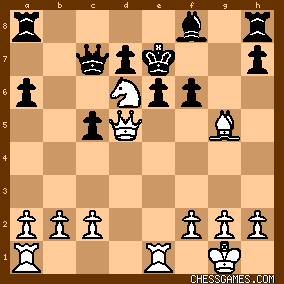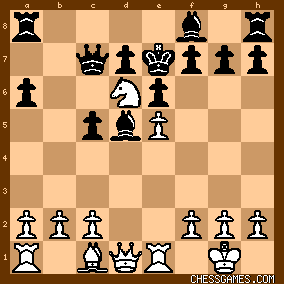|
< Earlier Kibitzing · PAGE 3 OF 3 ·
Later Kibitzing> |
| Nov-05-08 | | JG27Pyth: Wow, I can't remember the last time I was so completely hosed by a Wednesday... Just didn't see Qxd5. At all. Somedays you don't have it. :( Thanks Kibitzers for the full analyses... I see it all now. |
|
| Nov-05-08 | | gambitfan: <Manic: My line for 13...♔e7 was slightly inferior. It goes 14.♗g5+ f6 15.exf6+ ♔xd6 (15...♔d8 16.fxg7+) 16.♗f4+ winning the queen for a minor.> and what about 16... e5 ? Black ♕ is not yet won... White left a ♘ for a ♙ ; the situation is not particularly favourable for them now... |
|
| Nov-05-08 | | gambitfan: <TCS: 13 Nd6+ Ke7 14. Bg5+ f6 15 Qh5! (threatening Qf7+ and Qe8#) g6 16 Bxf6#> Excellent and subtle line !

click for larger view16 ♗xf6#
|
|
| Nov-05-08 | | Patriot: I didn't even consider 14.Qxd5 probably because it "loses" the queen. But of course when analyzing nothing is actually lost except the time it takes to consider the move. |
|
Nov-05-08
 | | Jimfromprovidence: 12...Qc6, threatening mate-in-one, looks like the stopper.
click for larger view Now, 13 Nd6+ loses the knight to 13...Bxd6. |
|
| Nov-05-08 | | ongyj: Does the inferior-looking 14.exd6 also work? For instance 14...Qxd6 15.c4 ? |
|
| Nov-05-08 | | kevin86: This is one of these combinations that have the subtlety of a pickpocket. After 14...exd5 15 exd6+ and 17 dxc7 regaining the queen and ending a piece ahead. Otherwise,the double attack on rook and bishop gains white a piece. It's either the tiger or the tiger. |
|
Nov-05-08
 | | chrisowen: I cant decide what move I'd play instead of 13.Nd6 as it just kind of leaps out. 10..d5 looks worth considering in the position. |
|
| Nov-05-08 | | Oliveira: Guys, are you kidding me?
13.♘d6+!, ♔e7; 14.♗g5+, f6; 15.exf6, gxf6; 16.♕xd5!,fxg5; 17.♕xa8, ♕xd6 [17... ♗g7; 18.♘f5+, ♔f6; 19.♕e4, exf5; 20.♕e7+, ♔g6; 21.♖e6+  ]; 18.♖ad1 ]; 18.♖ad1  Position after 16.♕xd5

click for larger view |
|
| Nov-05-08 | | agb2002: The line 13.Qxd5 exd5 14.Nd6+ Bxd6 15.exd6+, winning a piece, fails miserably to 14... Ke7. Hence, one would try a different move order, starting with 13.Nd6+: A) 13... Bxd6 14.Qxd5 (double threat) exd5 15.exd6+ Kd8 16.dxc7+ with a piece ahead. B) 13... Ke7 14.Qh5 (forcing more weaknesses) g6 15.Bg5+ f6 16.Bxf6 mate. C) 13... Kd8 14.Nxf7+ and 15.Nxh8 winning. |
|
| Nov-05-08 | | YouRang: When you've got a rook on the same file as the opposing king, it's a good place to sniff around for tactics. In this case, we've got one of our pawns and one of his pawns between the R and K. Removing one of those pawns produces either a pin tactic or a discovered check tactic. The observation that Ra8 is in take after Qxd5 also comes into view as the move to displace black's e-pawn. How do we displace our e-pawn? 13.Ne6+! appears to be the only way, and it's a forcing move leaving black with limited options. The easiest response to deal with is 13...Bxe6, which springs the discovered check tactic: 14.Qxd5!, recovering our piece and threatening exd6 and Qxa8. Of course, 14...exd5 exd6+ picks up a bishop, and clears the pawns from the e-file giving us the queen-recovering discovered check. If 14...Be7, then 15.Qxa8+ and winning, while 14...Ke7 (guarding Ra8 with Rh8), loses to 15.exd6+, a K+Q pawn fork. Much more difficult was what to do if 13...Ke7. Black is in bad shape, and so far we haven't invested any material, but are we winning? Hunting for ideas, I tried to deliver check with 14.Bg5+, which would be mate except that black's can block with 14...f6. It took me a while to see that 15.Qh5! is the winning shot in this line, threatening 16.Qf7+ Kd8 17.Qe8#. First, the easy part:
If 15...fxg5 then 16.Qxg5#
If 15...g6 then 16.Bxf6#
Now the hard part:
If 15...Qb6 (to vacate c7 for the K to escape mate), then we need a B for P sac to exploit the queen's power on the k-side: 16.Bxf6+ gxf6 and now 17.Qf7+ Kd8 18.Qxf6+ picking up another P and forking K+Rh8. White ends up the exchange and a pawn to the good. |
|
| Nov-05-08 | | MiCrooks: To Wizard
The reason you cannot forget about the Rook on a8 is not to deal with exd5 (how could it be - the piece threatening the Rook just got removed from the board). The reason is that otherwise Black could just play Be7 and play on. Your great combination would have netted you nothing without the Rook hanging on a8! |
|
| Nov-05-08 | | agb2002: This puzzle is subtler than I figured out. It takes some time to find the best winning line after 13.Nd6+ Ke7 14.Qh5 Qb6(a7,a5). However, I don't think that Black could survive to a plan based on Bg5-Tad1-c4-Qf7, in the adequate order. |
|
| Nov-05-08 | | rodantero: I think in the variant
13.d6+! e7 14.g5+ f6 15.exf6 gxf6 it's also posible
16.Nf5+ Kf7 [16...Kd8 17.Bxf6+ Kc8 18.Bxh8] 17.Qh5+ Kg8 18.Bxf6 exf5 [18...d6 19.Re3] 19.Qg5+ Kf7 20.Re7+!! Bxe7 21.Qg7+ Ke6/8 22.Qe7# |
|
| Nov-05-08 | | TheaN: 3/3
Dubious claim by myself... I got the winning lines but missed Black's opportunity of Qa5?! and Kd8! to defend against mate. And for some reason, they seem to hold. <13.?>
White: a2, b2, c2, e5, f2, g2, h2, Nc4, Bc1, Ra1, Re1, Qd1, Kg1 Black: a6, c5, d7, e6, f7, g7, h7, Bd5, Bf8, Ra8, Rh8, Qc7, Ke8 Material: = (-♗/♘)
Candidates: Qxd5, <[Nd6†]> -ML-
White has clear chances here, but the immediate Qxd5! fails because the discovery check cannot yet be performed: it has to be noted that that is a clear characteristic of this position: the e-pawn with a Rook on it that can discover on d6 and attack the Queen. No, White has to get on d6 first. And that, is immediately available. <13.Nd6†> replies a plenty. Drawing, none. /A\
<13....Qxd6 14.exd6  > lets forget that. > lets forget that. /B\
<13....Kxd8 14.Nxf7†  > lets forget this as well, maybe a little less than Qxd6 though. > lets forget this as well, maybe a little less than Qxd6 though. /C\
<13....Bxd6> now things get interesting. Now the clear discovery is there, but now there is no check. Having the e6♙ 'pinned', however, allows a foul strike. <14.Qxd5!  > returning to material balance, but this is threatening Qxa8† and Qxd6 which are not both avoidable unless Black captures. However, that allows: 14....exd5 15.exd6† Kd8 16.dxc7†. Black is lost. > returning to material balance, but this is threatening Qxa8† and Qxd6 which are not both avoidable unless Black captures. However, that allows: 14....exd5 15.exd6† Kd8 16.dxc7†. Black is lost. /D\
<13....Ke7!> nonetheless, Black can avoid all this by simply moving out of the way. Now the strike goes to f7, in a different way. <14.Qh5> Black is in a pinch. He cannot simply block this threat on f7. /DA\
<14....g6 15.Bg5† f6 16.Bxf6‡ 1-0> or with the Queen, that is irrelevant in this position. /DB\
<14....Kd8 15.Nxf7†> allows once again the exchange win, but: /DC\
<15....Qa5!!> is an incredible safe. <16.Bg5 f6 17.Be5  > and the win, is not there. Right? At least way beyond Wednesday... > and the win, is not there. Right? At least way beyond Wednesday... |
|
| Nov-05-08 | | Samagonka: This one was tricky. I call it "Queen-sac reloaded". Am I aloud to say YES WE CAAANNN!!! on this blog? |
|
Nov-05-08
 | | gawain: This one is evil! And it's only Wednesday.
I knew that Qxd5 was involved and I knew that Nd6+ was involved and I saw that there would be a discovered check if the e pawn got to take on d6 but I still did not see the combination--because I did not notice the hanging rook at a8. |
|
| Nov-05-08 | | TheaN: No wait, I meant, in my final analysis, <17.Bf4 >! That actually evaluates +5(!) as White is threatening <18.exf6†> which almost forces <17....Kd8> with <18.Nf7†> and at least the exchange win, but looking a bit further shows it's a Rook. Nonetheless, <17.c4!> is the best move. The Bishop is guarding too much, and this threat crushes Black. The most non-obvious winning move here is <17....Bc6>, followed by <18.exf6†!!>, and if <18....gxf6 (Kxd6 19.Bf4† e5 20.Qxe5‡ 1-0 / Kd8 19.fxg7†)> White mates with another sac attempt <19.Bxf6†!!> concluding the combination. If <19....Kxf6 (Kxd6 20.Qe5‡ 1-0)> the Rook can enter freely with <20.Qf7† Kg5 21.Re5† Kg4 (Kh6 22.Rh5‡ 1-0 / Kh4 22.Qf4‡ 1-0) 22.Qh5† Kf4> and White can even mate with a pawn, with no Black piece in sight... <23.g3‡ 1-0>. Okay, hands up. Who did NOT see THIS? |
|
| Nov-05-08 | | gazzawhite: <Oliveira>: If 13. Nd6+ Ke7; 14. Bg5+ f6; 15. exf6+ gxf6; 16. Qxd5, what about 16...Bg7? |
|
| Nov-05-08 | | veerar: I am surprised by Black's 11...c5,as d5,in the Sicilian is the freeing move and should be played as early as possible. |
|
| Nov-07-08 | | Manic: <gambitfan> If you ever see this 16...e5 17.Bxe5+ |
|
| Aug-03-13 | | Oliveira: This comes rather late, but I'm sorta revisiting the past, so to speak: <gazzawhite: <Oliveira>: If 13. Nd6+ Ke7; 14. Bg5+ f6; 15. exf6+ gxf6; 16. Qxd5, what about 16...Bg7?> Well, White is a piece up! Besides, I suppose 17.♗f4 Δ ♘f5+ would land the game rather quick: 
click for larger viewI) 17... e5 18.♘f5+
II) 17...♕c6 18.♖xe6+!
III) 17...♖a7 18.♘f5 ♔f8 19.♗d6+ ♔g8 20.♖xe6! dxe6 21.♕xe6+ ♕f7 22.♕c8 ♗f8 23.♘h6+, winning the ♕] IV) 17...♖ag8 18.♘f5+ ♔f8 [18...♔f7 18.♘h6+ ♔f8 19.♗d6+ ♔e8 20.♕h5+  ] 19.♗d6+ ♔f7 20.♘h6+ ♗xh6 21.♕h5+} ] 19.♗d6+ ♔f7 20.♘h6+ ♗xh6 21.♕h5+} V) 17... ♕a7 18.♕h5 ♖af8 ♘f5+ and White wins another piece} VI) 17...♕d8 is better as far as I can see, but it's a submissive move and White is free to proceed with the attack. For instance: 18.♘b7 ♕c8 [♔f8 19.♗d6+ ♔e8 20. ♖xe6+!] 19.♗d6+ ♔f7 20.♕h5+ ♔g8 21.♘xc5 etc. |
|
| Aug-03-13 | | Oliveira: <jokerman1981q: for those who are interested here is a game i played in 1987 S.East R Trotter 1987 northshore open b grade 1 e4 a6 2 d4 b5 3 a4 b4 4 bc4 e6 5nf3 bb7 6 d5 nf6 7 de fe 8 e5 nd5 9 o-o c5 10 bnd2 nb6 11 re1 nc4 12 nc4 bd5 13 bg5 qc7 14 nd6 bd6 15 qd5 be5 qa8> Wow, same trap! That's curious. |
|
| Aug-03-13 | | Oliveira: Now that I think of it, maybe it would be better to combine my variation with the one most people found out here!
click for larger viewPosition after 13...♔e7
Therefore, 14.♗g5+ f6 15.♕h5 and mate follows unless Black gives up the ♕! |
|
| Aug-03-13 | | Oliveira: Well, <TCS> had found it already. Sigh. <TCS (Nov-05-08): Time for a very short post. There are a couple of critical lines13.Nd6+ Bxd6 14.Qxd5!
13 Nd6+ Ke7 14. Bg5+ f6 15 Qh5! (threatening Qf7+ and Qe8#) g6 16 Bxf6# Great puzzle> |
|
 |
 |
|
< Earlier Kibitzing · PAGE 3 OF 3 ·
Later Kibitzing> |
|
|
|





